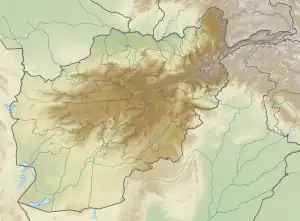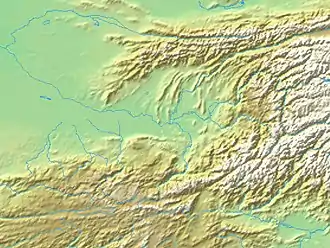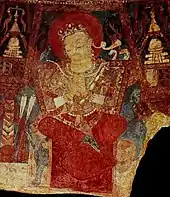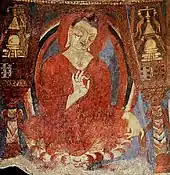Kakrak Valley
درهٔ ککرک | |
|---|---|
 Kakrak Valley  Kakrak Valley  Kakrak Valley  Kakrak Valley | |
| Coordinates: 34°48′36″N 67°51′09″E / 34.809877°N 67.852553°E | |
| Country | |
| Province | Bamyan Province |
| Population | |
| • Ethnicities | Hazara people |
| Time zone | + 4.30 |
Karkak Valley (Dari: درهٔ ککرک) is a valley in central Afghanistan, located in Bamyan province, 120 km west of Kabul province.
The famous Buddhist mural named "The Hunter King" (7-8th centuries CE) shows a typically local royal figure seated on a throne, his bow and arrows on the side. He wears a triple-crescent crown which has been compared to the triple-crescent crowns on the coinage found in northeastern Afghanistan in the area of Zabulistan, such as a coin found in Ghazni.[1] Late 7th to early 8th century CE.[2][3] Other authors have attributed the triple-crescent crown to Hephthalite influence.[4] The painting may be an allegory of a King abandoning violence, particularly the hunting of animals, and converting to Buddhism.[5]
Murals from Kakrak
 The triple-crescent crown in the "Hunter King" mural from Kakrak (7th-8th century CE) has been compared to the triple-crown in some of the coinage of Afghanistan.[1][3] Wall paintings from the 7th-8th century, Kabul Museum.[4]
The triple-crescent crown in the "Hunter King" mural from Kakrak (7th-8th century CE) has been compared to the triple-crown in some of the coinage of Afghanistan.[1][3] Wall paintings from the 7th-8th century, Kabul Museum.[4] Seated Buddha, Kakrak
Seated Buddha, Kakrak Coupole, Kakrak. Bamiyan. Musée national des arts asiatiques Guimet.
Coupole, Kakrak. Bamiyan. Musée national des arts asiatiques Guimet.
See also
Wikimedia Commons has media related to Kakrak.
References
- 1 2 Hackin, Joseph (1936). L'Œuvre de la Délégation Archéologique Française en Afghanistan (1922-1932) : vol.1. p. 49.
- ↑ Göbl 1967, 254 ; Vondrovec tyre 254
- 1 2 Alram, Michael; Filigenzi, Anna; Kinberger, Michaela; Nell, Daniel; Pfisterer, Matthias; Vondrovec, Klaus. "The Countenance of the other (The Coins of the Huns and Western Turks in Central Asia and India) 2012-2013 exhibit: 14. KABULISTAN AND BACTRIA AT THE TIME OF "KHORASAN TEGIN SHAH"". Pro.geo.univie.ac.at. Kunsthistorisches Museum Vienna. Retrieved July 16, 2017.
- 1 2 Compareti, Matteo (2008). "The Painting of the "Hunter-King" at Kakrak: Royal Figure or Divine Being?". Studio Editoriale Gordini: 133.
- ↑ "According to Jäger's interpretation, the so-called "Hunter-King" was a symbolic representation of a royal person who converted to Buddhism and abandoned hunting and violence in general." inCompareti, Matteo (2008). "The Painting of the "Hunter-King" at Kakrak: Royal Figure or Divine Being?". Studio Editoriale Gordini: 133.
This article is issued from Wikipedia. The text is licensed under Creative Commons - Attribution - Sharealike. Additional terms may apply for the media files.
